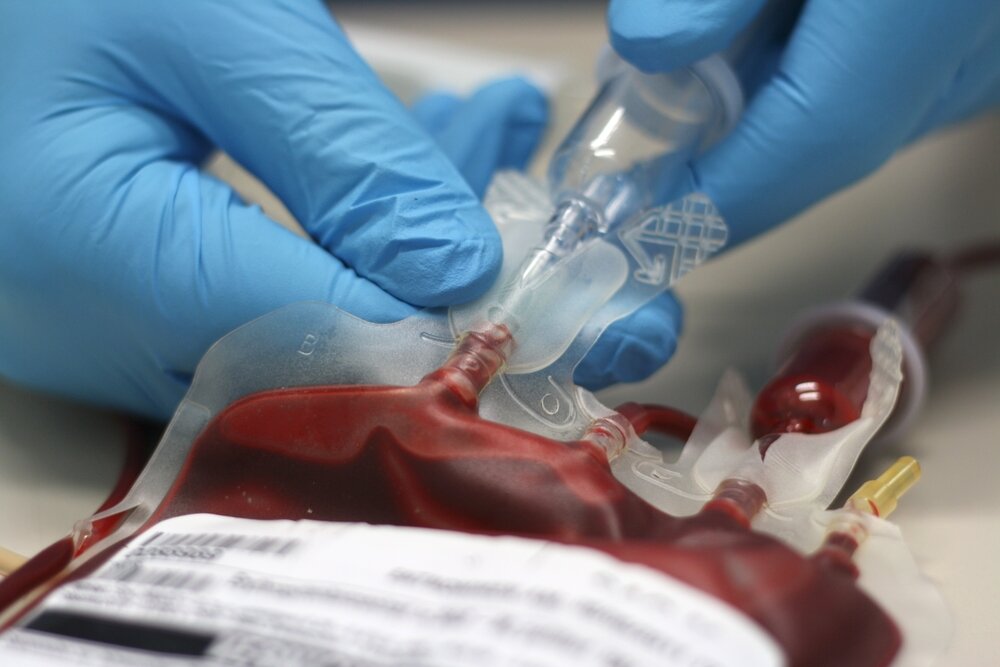A blood transfusion is when a volume of donor blood is given to your body during a time of crisis. This acts as a supplementation to the blood your body naturally provides, restoring normal levels of red blood cells, plasma, and platelets.
You must sign a consent form prior to a blood transfusion, and your blood type must be checked to ensure you receive a compatible transfusion.

You will be asked to sit or lie down and will have an IV inserted into a vein. This will be connected to a bag of blood which will slowly get absorbed into your own bloodstream. On average, it takes around 4 hours to complete a transfusion of 1 bag of blood.
What are the different blood types?
There are 4 main types of blood - A, AB, B, and O. As well as this, your blood group can be RhD positive or negative, meaning there are a total of 8 blood types.
O is the most common blood type and has no antigens on the surface of the red blood cells. It has both anti-A and anti-B antibodies in the blood plasma.
A has A antigens on the surface of the red blood cells and anti-B antibodies in the plasma. B is the same but reversed.
AB has no antibodies in the plasma, but has A and B antigens on the surface of the red blood cells.
RhD antigens are sometimes present in red blood cells. This is an extra protein, and its presence means that your blood group is positive. If it is not there, your blood group is negative.
Why would you need a blood transfusion?
If you are involved in an accident and lose a lot of blood, you are likely to need a blood transfusion to replenish your body. This could be as a result of surgery or childbirth too.
You may need a transfusion for another reason that causes your body to be lacking in red blood cells. This may be due to a medical condition such as thalassemia or sickle cell disease, which impacts the function of red blood cells.
Other blood transfusion recipients may be those suffering with leukemia, stem cell transplants, chemotherapy. Cancers tend to impact the entire body and sufferers will often need some supplementation.
What are the risks of a blood transfusion?
Blood transfusions are common procedures and provided you are given the correct blood group, there are minimal risks involved.
Blood must be checked before it is given as a transfusion. This ensures there are no serious infections in the donor blood, for instance, HIV and hepatitis.
Despite all the tests that are carried out, there is still a risk of your body reacting to the transfusion. You may have an allergic reaction which could present as hives, fever, and itching.
There are 3 main, but rare conditions that could happen following a blood transfusion. Acute immune hemolytic reaction is when your immune system attacks the donor red blood cells because they are not compatible with your body. This can cause kidney damage due to the substances released in your body to react to the transfusion.
Delayed hemolytic reactions are a similar process, but occur much more slowly. It can take up to a month to notice a decline in red blood cell levels.
The other main reaction to a transfusion is something known as Graft-versus-host disease. This is where the white blood cells that have been transfused into your body begin to attack your body’s own bone marrow. This is most likely to affect people with very weak immune systems and unfortunately, is often fatal.
What happens if you get the wrong blood in a blood transfusion?
This can result in an allergic reaction, as described above.
So does a blood transfusion change your DNA?
There are 4 main components of blood: red blood cells, plasma, white blood cells, and platelets. The only part of blood that contains a nucleus, and therefore donor DNA, is the white blood cells. As a rough percentage of the blood transfusion, white blood cells make up less than 1%.
This means that barely any donor DNA actually ends up making its way into your body. For context, a single pint of blood will contain around 4 trillion micro-organisms, of which white blood cells make up roughly 1 billion.
Every single day, your body is capable of creating around 5 billion white blood cells. The donor DNA is simply overwhelmed by the amount of your own DNA and thus your genetic makeup is rarely affected.
White blood cells also only have a lifespan of 3-4 days and do not replicate. This means that in most cases, after 4 days any trace of foreign DNA should have disappeared from your body.
Donor DNA following a blood transfusion can be detected in the body through a process known as PCR - a polymer chain reaction. This uses a series of temperature changes to copy and exponentially amplify a small section of a DNA sequence. This makes it much easier to study the DNA sample, and allows you to pinpoint the presence of foreign (donor) DNA.
The length of time foreign DNA can be detected in your body varies depending on how much blood you had transfused. Large scale transfusion patients have been tested post-transfusion to determine whether donor DNA can be detected in their bodies. In some cases, this has been detected up to a year and a half post-procedure.
Even in these extreme cases, the donor DNA has never been found to be overpowering the body’s original DNA. Your body’s innate DNA structure will always retain dominance.
When can you not donate blood?
There are many rules concerning blood donation, and you should check with the restrictions in your local area before donating. The AABB (American Association of Blood Banks) has created a list of reasons for donor deferral.
These include people that have injected non-prescription substances, such as drugs or steroids in the last 3 months. If it is a medical injection, speak to the blood bank as to what your best course of action is.
If you have a positive HIV test, or are a man that has had sexual contact with other men in the past 3 months, you also cannot donate blood. If you have engaged in sex for money or drugs in the last 3 months, you cannot donate blood.
If you take a drug known as Tegison for psoriasis, you cannot donate blood. This is because this drug is known to cause birth defects. The blood that you donate may get given to a pregnant woman and the risk is too great.
If you have suffered from babesiosis, a parasitic infection in the red blood cells, you cannot donate. The same applies to Chagas disease, another parasitic blood infection. As these are blood-borne illnesses, you run the risk of infecting others via donor blood.
A disease called CJD - Creutzfeldt-Jakob Disease also means that you cannot donate blood. It is a degenerative brain disorder and around 70% of people diagnosed with it die within a year of initial diagnosis. Due to the high mortality rate, people with CJD cannot donate blood in an attempt to limit the spread.
There are many risk factors for vCJD that you will need to check your compliance with prior to donating.
When you get deferred from a blood bank you will be told whether it is a permanent or temporary deferral.
How do you feel while having a blood transfusion?
You will feel a sharp scratch when the needle is inserted into your vein. During the transfusion you should not feel anything. A nurse will keep checking on you throughout the transfusion procedure.
You should make them aware immediately if you feel unwell. It may result in a temperature, chills, or a rash developing. These are not concerning and can be treated with paracetamol and a slower rate of transfusion.
For a few days after the transfusion the site may be tender and bruised, but this will cure itself in time.
If you develop difficulty breathing, chest pain, back pain, or feel unwell in the 24 hour period following a transfusion, please contact a doctor immediately.
What would happen if we could change our DNA?
This would make the job of the police almost impossible. Criminals would have the ability to modify their individual DNA footprint and evade detection much more easily than they currently can.
There is work being done into gene editing currently. This can correct, modify, replace, and delete faulty DNA. This can be used to help cure genetic disorders as scientists can essentially rewrite DNA sequences that are causing issues in the body.
Eventually, this could be used to ‘fix’ defective genes found in human embryos and prevent more people being born with serious diseases. This is a controversial topic however, as it interferes with nature.
